Fungal Nail Infections (Onychomycosus)
Onychomycosis is a fungal infection of the toenails or fingernails. Onychomycosis causes fingernails or toenails to thicken, discolor, disfigure, and split.
At first, onychomycosis appears to be only a cosmetic concern. Without treatment, however, the toenails can become so thick that they press against the inside of the shoes, causing pressure, irritation, and pain. Fingernail infection may cause psychological, social, or employment-related problems.
Half of all nail disorders are caused by Onychomycosis, and it is the most common nail disease in adults. Toenails are much more likely to be infected than fingernails. The incidence of Onychomycosis has been increasing and is related to diabetes, a suppressed immune system, and increasing age. Adults, especially the elderly, are more likely to have Onychomycosis than children.
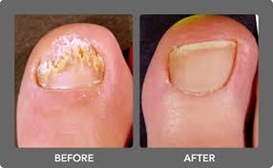
Fungal nail infections are common. They’re not serious but they can take a long time to treat. The nail becomes brittle and pieces can break off. It can cause pain and swelling in the skin around the nail.
Fungal nail infections usually affect your toenails but you can get them on your finger nails too.
If you have diabetes you should see a Podiatrist because any foot injury can lead to complications.
Treating Fungal Nail Infections
Fungal nail infections develop when your feet are constantly warm and damp. You’re more likely to get an infection if you wear trainers for a long time and have hot, sweaty feet. Treat athlete’s foot as soon as possible to avoid it spreading to the nails.
To prevent fungal nail infection:
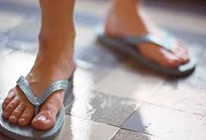
Treating minor fungal nail infections
If this is just at the end of the toenail or has been present for a long time and has not changed. These may not need medication.
Treating up to three fungal nails not involving the lower 1/3
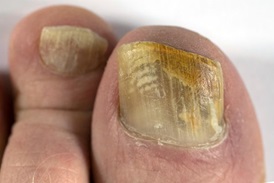
If the look of your nail bothers you, it’s painful, or it starts to involve multiple toenails. Antifungal nail creams, lacquers or paints: It can take up to 12 months to cure the infection and doesn’t always work.
Treating 4 or more infected toenails
In an adult with severe or extensive disease, or when topical treatment has failed or has spread to other nails oral treatment should be considered.
Oral Treatment
A positive microscopy or a positive culture of skin scrapings is recommended before starting treatment. If test results are negative but the clinical appearance is very suggestive of fungal infection, repeat the sample and start treatment.
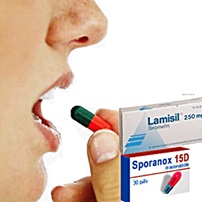
You need to take tablets every day for up to 6 months.
Tablets can have side effects including:
Surgery
Surgical approaches to onychomycosis treatment include surgically or chemically removing the nail (nail avulsion or matrixectomy).
Laser
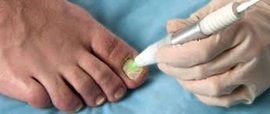
Laser treatment uses laser to destroy the fungus. The laser delivers light energy to heat the toenail bed and kill the toenail fungus and fungal spores. This process makes the laser ideal for the safe and effective desired result of toenail clearing.
The laser energy alters fungal cellular metabolism and at increased temperature (42°C), fungal organisms’ cell components are damaged. There is also a photo-chemical effect that further damages fungal cell enzymes and proteins. Fungal cell membranes are also damaged by the laser resulting in fungal death and toenail clearance. There’s little evidence to show it’s a long-term cure as most studies only follow patients for three months. You won’t notice anything immediately following treatment. However, as your nail grows out, the new nail growth should be clear. Toe nails grow slowly –especially nails infected with fungus. So, it may take 6-12 months for your toenail to clear.
Photodynamic therapy (PACT)

PACT has been used in medicine since the 1990’s. PACT is a safe form of intensive light therapy. It uses a specific wavelength that kills fungus. A blue PACT gel, is applied to the affected nails and is activated by exposure to the PACT light; together they destroy only the diseased part of the nails.
The photosensitive agent specific to toenail fungus is a pharmaceutical grade blue dye, methylene blue. The typical course of treatment involves a series of 4 sessions. In each session we will apply a generous amount of the methylene blue, and apply the medical light to the affected nails for several minutes. We will also often debride/ reduce the thickness of the dead nails such that the dye has the best penetration possible. We complete each treatment 3 weeks apart such that the entire treatment spans just over 12 weeks. After the 4 treatments are complete, we typically see our patients every 4-6 weeks so that we may clean the dead nail as much as possible and expose the healthy regrowth. This is an important step in making sure that the infection does not return. We also provide our clients with a complete home care regimen, so that treatments are even more effective and we see results sooner.
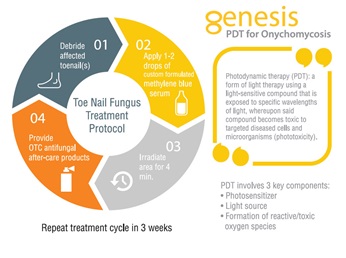
Nice Guidelines
Fungal skin infection - foot
Last revised in September 2014
